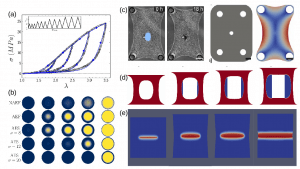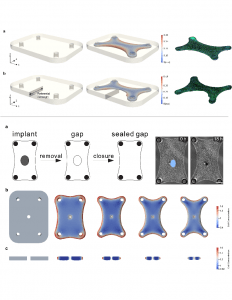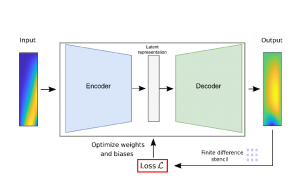Beyond phenomenological constitutive modeling
Machine learning techniques are gearing up to play a significant role in the field of physical response of materials, enabling the i) interpretation of experimental data, ii) acceleration of computational techniques for multi-scale modeling, and iii) development of surrogate models for materials discovery and microstructure optimization. Data-driven constitutive laws have gained traction in recent years for various reasons, precisely, their ability to allow for the direct utilization of experimental data or for their potential speed up of complex and time-consuming simulations. We are utilizing and developing machine learning approaches towards enhancing data-driven techniques with physical consideration, towards forward and inverse problems that involve nonlinear, anisotropic, and history dependent material responses.
- J Elasto-plasticity with convex model-data-driven yield functions, hal.archives-ouvertes.fr/hal-03619186v1
- N Fuhg, L van Wees, M Obstalecki, P Shade, N Bouklas, M Kasemer, (2022) Machine-learning convex and texture-dependent macroscopic yield from crystal plasticity simulations. arXiv preprint arXiv:2202.01885
- Fuhg, J. N., & Bouklas, N. (2021). On physics-informed data-driven isotropic and anisotropic constitutive models through probabilistic machine learning and space-filling sampling. Computer Methods in Applied Mechanics and Engineering,
- Fuhg, J.N., Bouklas, N. and Jones, R.E., 2022. Learning hyperelastic anisotropy from data via a tensor basis neural network. Journal of Mechanics and Physics of Solids
- Fuhg, J.N., Marino, M. and Bouklas, N., 2022. Local approximate Gaussian process regression for data-driven constitutive models: development and comparison with neural networks. Computer Methods in Applied Mechanics and Engineering, 388, p.114217.
- Fuhg, J.N., Böhm, C., Bouklas, N., Fau, A., Wriggers, P. and Marino, M. (2021). Model-data-driven constitutive responses: application to a multiscale computational framework. International Journal of Engineering Science, 167, 103522
Multiphysics of synthetic soft materials
Polymers and hydrogel can be highly deformable, tough, and resilient are ideal for use in a wide variety of biomedical and soft robotics applications . Our research aims to better the underlying nonlinear mechanical and multiphysical phenomena that govern the response of these materials. We approach these problem from a multiscale standpoint, as consider problems from the structural level down to the single chain and bond level. Specifically one of the problems that we are interested in, which is macroscale specimen failure (damage and fracture), are directly informed from chain-level damage that has to account for bond rupture. These models can be statistical mechanics-informed, physics-informed, or phenomenological.
- Mulderrig, J., Talamini, B. and Bouklas, N., (2022). A statistical mechanics framework for polymer chain scission, based on the concepts of distorted bond potential and asymptotic matching. arXiv preprint arXiv:2208.07352.
- Ang, I., Bouklas, N. and Li, B., (2022). Stabilized formulation for phase‐field fracture in nearly incompressible hyperelasticity. International Journal for Numerical Methods in Engineering.
- Li, B. and Bouklas, N., 2020. A variational phase-field model for brittle fracture in polydisperse elastomer networks. International Journal of Solids and Structures, 182, pp.193-204.
- Lamont, S. C., Mulderrig, J., Bouklas, N., & Vernerey, F. J. (2021). Rate-Dependent Damage Mechanics of Polymer Networks with Reversible Bonds. Macromolecules.
- Ang, I., Liu, Z., Kim, J., Hui, C.Y. and Bouklas, N., 2020. Effect of elastocapillarity on the swelling kinetics of hydrogels. Journal of the Mechanics and Physics of Solids, p.104132
- Mulderrig, J., Li, B. and Bouklas, N., (2021).Affine and non-affine microsphere models for chain scission in polydisperse elastomer networks. Mechanics of Materials, p.103857.

Cartilage: from morphogenesis to damage and disease
Cartilage is a soft biological material with unique mechanical properties because of the important load-bearing role it has in the human body. During morphogenesis, cartilage differentiates from an isotropic material to an anisotropic material with unique zonal distribution from the bone to the articulating surface. Despite being a remarkably resilient material, cartilage form and functionality can degenerate over time through the disease state of osteoarthritis. OA is difficult to diagnose in its early stage because damage initiates through small micro-cracks too difficult to see through diagnostic x-rays. In our research we seek to investigate the morphogenesis of cartilage but also the transition from damage to fracture through the development of computational framework that can account for dynamic loading and failure at the limit of incompressibility. In cartilage, the hierachical multiphase structure of collagen fibrils and proteoglycans form a resilient soft material that is hard to replicate synthetically which is an ongoing biomaterials challenge.
- Darkes-Burkey, C., Liu, X., Slyker, L., Mulderrig, J., Pan, W., Giannelis, E.P., Shepherd, R.F., Bonassar, L.J. and Bouklas, N., (2022). Simple synthesis of soft, tough, and cytocompatible biohybrid composites. Proceedings of the National Academy of Sciences, 119(28), p.e2116675119.
- Kim, B., Middendorf, J.M., Diamantides, N., Cohen, I., Bouklas, N. and Bonassar, L.J., (2022). The role of buckling instabilities in the global and local mechanical response in porous collagen. Accepted: Experimental Mechanics, 1-11.
Cell/ECM mechanics and mechanotransduction
We are interested in understanding the physical principles and underlying coupled multiphysical processes that govern cell-ECM mechanics and mechanotransduction. Motivated by experimental observations, our research goal is to derive theoretical and computational models that enable us to conduct hypothesis driven research that is not possible from a purely experimental perspective. Specifically we start from studying cell-laden microtissue models, and develop theories that can recapitulate their response-in terms of contractility, cell migration and ECM realignment- , to loading, damage and microsurgical manipulation that triggers morphogenetic processes.
- Mailand, E., Li, B., Eyckmans, J., Bouklas, N. and Sakar, M.S., 2019. Surface and bulk stresses drive morphological changes in fibrous microtissues. Biophysical journal, 117(5), pp.975-986.
- Kim, J., Mailand, E., Ang, I., Sakar, M.S. and Bouklas, N., 2020. A model for 3D deformation and reconstruction of contractile microtissues. Soft Matter.
- Uslu, F. E., Davidson, C. D., Mailand, E., Bouklas, N., Baker, B. M., & Sakar, M. S. (2021). Engineered Extracellular Matrices with Integrated Wireless Microactuators to Study Mechanobiology. Advanced Materials, p.2102641.
- Mailand, E., Özelçi, E., Kim, J., Rüegg, M., Chaliotis, O., Märki, J., Bouklas, N. and Sakar, M.S., (2022). Tissue engineering with mechanically induced solid‐fluid transitions. Advanced Materials, p.2106149.
- Rossy, T., Distler, T., Pezoldt, J., Kim, J., Tala, L., Bouklas, N., Deplancke, B. and Persat, A., 2022. Pseudomonas aeruginosa contracts mucus to rapidly form biofilms in tissue-engineered human airways. BioRxiv. doi: https://doi.org/10.1101/2022.05.26.493615
Multiscale mechanics of tendon
Tendinopathy affects a large fraction of the population. The major factor contributing to the initiation of tendon damage and the onset of tendinopathy is the repetitive load of tendons. We investigate the fatigue-induced damage progression in tendons by means of multiscale models which incorporate the hierarchical and anisotropic nature of tendons. More specifically, we study how the instabilities of kink type emerge in tendons and the role that collagen fibril (discrete) plasticity plays in the onset of these instabilities altering the cell microenvironment. In this context, we also investigate how plasticity propagates through lengthscales in tendon and in what ways the multiscale plasticity alters the tenocyte micro-environment.
- Fontenele, F.F. and Bouklas, N., (2022). Understanding the inelastic response of collagen fibrils: A viscoelastic-plastic constitutive model. Acta Biomaterialia.
- Fontenele, F.F., Andarawis-Puri, N., Agoras, M. and Bouklas, N., (2022). Fiber plasticity and loss of ellipticity in soft composites under non-monotonic loading. International Journal of Solids and Structures, p.111628.
Data-driven and physics-informed solution of PDEs using AI
Partial differential equations (PDEs) are omnipresent in physics. Finding fast and accurate solutions to these equations however is still an open area of research. Towards this aim, we study two innovative frameworks that are currently revolutionizing every aspect of computational science and engineering. 1) We develop and apply machine learning algorithms such as neural networks to find solutions to forward and inverse problems. 2.) Rely on reduced order modeling techniques to build quick-to-evaluate surrogates based on existing PDE solution data.
- Fuhg, J.N. and Bouklas, N. (2022). The mixed deep energy method for resolving concentration features in finite strain hyperelasticity. Journal of Computational Physics, 451, 110839
- Fuhg, J.N., Karmarkar, A., Kadeethum, T., Yoon, H. and Bouklas, N., 2022. Deep Convolutional Ritz Method: Parametric PDE surrogates without labeled data. arXiv preprint arXiv:2206.04675.
- Fuhg, J.N., Kalogeris, I., Fau, A. and Bouklas, N., (2022). Interval and fuzzy physics-informed neural networks for uncertain fields. Journal of Probabilistic Engineering Mechanics, arXiv preprint arXiv:2106.13727.
- Kadeethum, T., O’Malley, D., Choi, Y., Viswanathan, H.S.,Bouklas, N., Yoon H., (2021). Continuous conditional generative adversarial networks for data-driven solutions of poroelasticity with heterogeneous material properties. https://arxiv.org/abs/2111.14984
- Kadeethum, T., O’Malley, D., Fuhg, J.N., Choi, Y., Lee, J., Viswanathan, H.S. and Bouklas, N., (2021). A framework for data-driven solution and parameter estimation of PDEs using conditional generative adversarial networks. Nature Computational Science, 1 (12), 819-829
- Kadeethum, T., Ballarin, F., Cho, Y., O’Malley, D., Yoon, H. and Bouklas, N., (2022). Non-intrusive reduced order modeling of natural convection in porous media using convolutional autoencoders: comparison with linear subspace techniques. Advances in Water Resources,104098



